
HOW TO PLAY VIDEO POKER
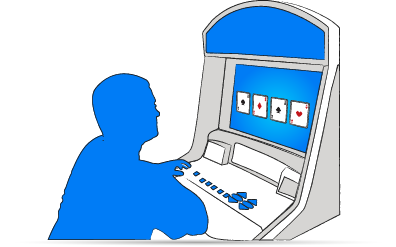
THE BASIC RULES WHEN PLAYING VIDEO POKER:







As with anything we do in life, there are certain inherent basics that relate to the process. This chapter will give you everything you need to fully understand how to play today’s wide array of video poker games.
You will learn how to play the game, the layout and importance of the pay table, as well as how to properly bet while playing video poker. You will learn and understand payback, return, house (and player) edge. You will learn about the implications of variance, sometimes called volatility. You will also learn what the term random really means when playing video poker.
These concepts are very important to understand if you are to make the most of your video poker play. So, let us begin.
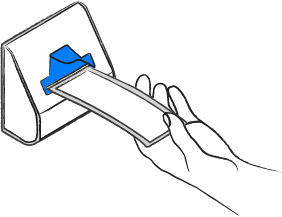
Video Poker play is relatively straight forward. The play of the game has similarities to other casino games, but it is definitely more complex than playing slot machines. To properly play a slot machine, you simply bet an appropriate amount to maximize your return from the game and either pull the handle or hit a spin button. There is nothing else to so. While it may be true that some slot machines have a button to immediately stop the spinning and go to the final result, pressing this button does not change the outcome; it only helps you lose your money a bit faster.
When you play video poker, you have decisions to make and those decisions have a definite impact on your winning or losing results. Because of this, a video poker player must do more than simply pull one lever or hit one button.
ADD CREDITS TO YOUR MACHINE
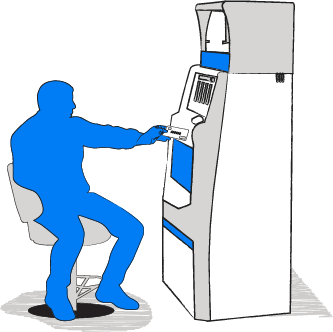
It wasn’t that long ago that the only way to add credits to a video poker machine was by inserting the proper denomination coins into the coin slot of the game. If you wanted to bet five credits per hand, you had to insert five coins per hand. If you should happen to have some winning hands, those credits would be added to the balance indicated on the machine and you could play them off without inserting any more coins. Should you score a nice win and cash out, your winnings were loads and loads of coins.
Thankfully those days are pretty much gone. While there may still be a few of these “classic” games still around, most games in play today accept currency. Cashing out has also improved with almost all games now in service. Today’s machines print out vouchers that can be cashed at the casino cage or in ticket changing machines scattered throughout the casino. The vouchers can also be inserted into other video poker games like currency.
The currency / voucher reader slots are in different places on different games, but they are clearly marked and will accept almost any denomination of currency. Whether you have $1, $5, $10, $20, $50, or $100 bills, they will all be accepted.
I find I like to put in sufficient credits for several minutes of play, usually a $20 bill on quarter machines or a $100 bill on dollar machines. You may choose to do the same or you may put in more or less. It is totally your choice.
SELECT YOUR DENOMINATION AND DESIRED GAME
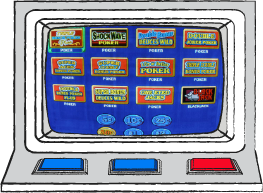
A typical layout of a video poker machine consists of a large screen that is used to display the hands that are dealt. It also displays all or part of the pay table. It identifies the denomination of the game and the number of credits available. It also generally identifies the current game being played. It may have small areas on the screen that you can touch to display more game information. If it is a multiple game machine it will have a small area on the screen labeled “More Games.”
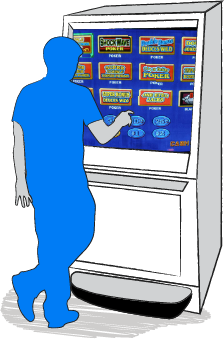
You first need to pick a denomination to play. Many of today’s video poker games are multiple denomination games. You can pick a denomination by touching the denomination displayed near the center on the bottom of the screen and then selecting your desired denomination (1¢, 5¢, 25¢, 50¢, $1, $2, $5, etc.) by touching it.
After you have selected a denomination, the screen will show all the games available for that denomination. Select the game you wish to play by touching the game’s name or image. You will be returned to the main screen for your selected game.
BEGIN PLAY

After we talked about how to play video poker, you are now ready to begin actual play. Most of today’s video poker games have touch screens. This means you can play using the buttons below the video screen or you can touch the screen to accomplish the same results. I find that using the buttons below the screen allow for faster and much more accurate play than touching the screen. In fact, about the only time I touch the screen while playing is if a button does not work properly. This is a personal preference, however.
To begin, press the “Play Max Credits” button. You could also press the “Bet One Credit” button several times, but unlike most slot machines, you always want to bet max credits while playing video poker. On subsequent hands you can press the “Deal/Draw” button rather than the “Play Max Credits” button as this button re-bets your previous bet. I prefer not to do that because I sometimes get “out of sync” and hit the “Deal/Draw” button before I have properly saved the cards I want to save. By pressing the “Play Max Credits” to start a new hand each time and the Deal/Draw button after holding the cards you want to save, there is no possibility you will redraw and replace your entire initial hand before holding any of them.
After pressing the max credits (or pressing bet one credit several times) your initial five card hand is dealt and displayed on the screen. You now must look at the hand and determine which cards you want to hold. Press the “Hold/Cancel” button underneath each card you want to hold. You can also touch each card you want to hold. If you make a mistake simply hit the “Hold/Cancel” button again to cancel the hold. You can also touch the card again to cancel the hold. To play your selected cards, hit the “Deal/Draw” button. The cards you did not hold will be replaced by different cards. If the resulting hand wins, the credits are added.
Some games have a “Double” feature, however most do not have it enabled. If the feature is enabled select whether or not you want to try to double you winnings. Most players chose not to try to double their win, but it is your choice.
The game is now ready for your next bet. Simply repeat the above process by hitting the “Max Bet” or “Deal/Draw” button. Continue to play until you are ready to leave. If you have credits in the machine, hit the “Cash Out” button. Your voucher will print out. Make sure to collect it before you leave the machine as there are those who watch for cash tickets that are left in the machine. It is entirely likely it will be gone in seconds if you leave the game without it.

THE VIDEO POKER PAY TABLE
This section examines the pay table. The video poker pay table contains the most important information available to the video poker player. It gives you everything you need in order to determine what type of game it is. From this information you can determine the return and volatility of that specific video poker game. The information from the pay table is the basis for determining the proper playing strategy for that game. Understanding this information is the key to maximizing your video poker playing experience.
THE VIDEO POKER PAY TABLE LAYOUT

Usually the entire video poker pay table is displayed on the video screen. Sometimes, however, part of the pay table is displayed on the screen and the rest is displayed elsewhere on the front of the game. Still other machines show part of the pay table on the screen and you have to touch a spot on the screen labelled “More Pays” or something similar to view the remainder of the pay table.
The general layout of video poker pay tables is always the same. The top line shows the royal flush followed by lower paying hands down to the lowest paying hand. Each line of the pay table has a description of the hand in the left column. To the right are several columns which show the pays for that hand with an increasing number of credits played. The first column shows the pay for having one credit in play. The second column shows the pay for two credits. Each column to the right is for one additional credit played. The last column is for maximum credits played. This is normally five credits.
A TYPICAL VIDEO POKER PAY TABLE: JACKS OR BETTER
Let us look a bit more closely at a typical pay table. One of the most common video poker games is Jacks or Better.
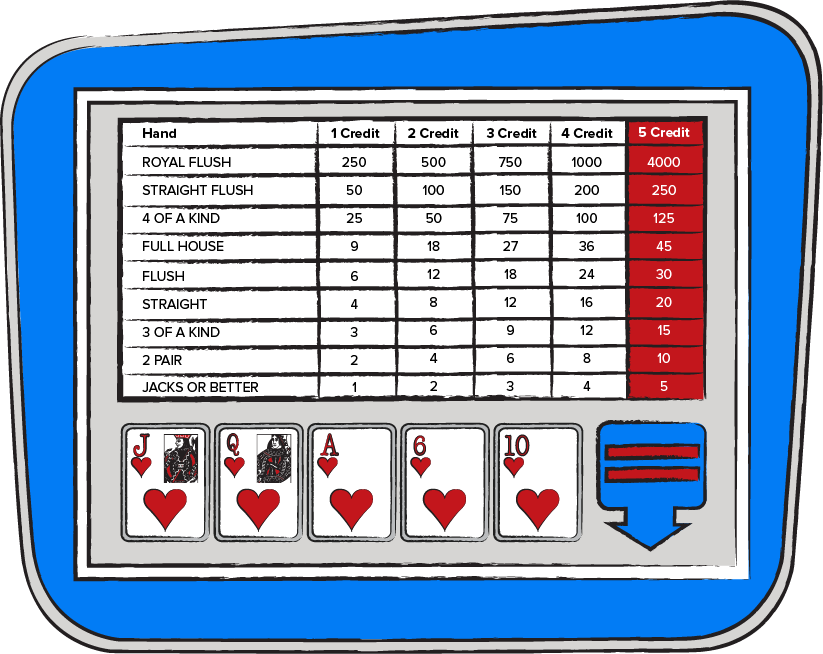
The information for a full pay (9/6) Jacks or Better game is shown below. A header row has been added for clarity. It is not shown on actual casino games. The game represented by this pay table is called 9/6 Jacks or Better because it pays nine credits per credit played for a full house and six credits per credit played for a flush. It takes a pair of Jacks or Better in order to have a winning hand.
The reason the pays for the full house and flush are used to define the game is that casinos tend to only modify the pays for these two winning hands when altering returns. They usually leave all the other pay lines alone. By stating the pays for those two hands, you know the pays for all possible winning hands.
As shown in the table above, the game of Jacks or Better has nine different types of paying hand: Royal Flush, Straight Flush, 4 of a Kind, Full House, Flush, Straight, 3 of a Kind, 2 Pairs and finally a pair of Jacks or Better which gives this game its name.
Notice that for each additional credit played, the winning amount also increases by the pay for one credit. For example, a pair of jacks or better pays one credit for one credit played, two credits for two credits played, and so on. Each additional credit adds one credit to the pay for the hand. The same is true for two pairs. One credit pays two credits, two credits pays four credits and so on. Each additional credit adds two credits to the win amount. The same is true for all of the hands in the table – all of them, that is, except the royal flush. The royal flush pays 250 credits with one credit played, 500 credits for 2 credits played, and so on. Each additional credit played pays an additional 250 credits, until you play the maximum credits of five. In that case, a royal flush pays 4,000 credits for five credits played, or put another way it pays 800 for 1.
THE DOUBLE BONUS POKER PAY TABLE
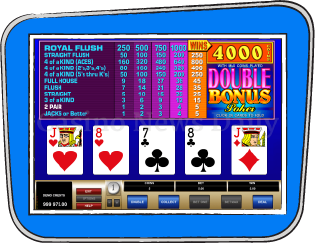
Whether you know how to to play this or other online casino games, we all know the that casino games can give you a bonus. The extra bonus for a royal flush with five credits played is the norm for video poker games. Virtually no other type of hand has a bonus pay for playing five credits. Other games will pay bonuses for certain hands, but the bonus is at the same ratio for any number of credits played. A look at the pay table for a Double Bonus Poker games will show you what I mean.
Notice in the table above that except for the royal flush, the pay for each additional credit played increases by the same amount per coin. The “double bonus” in the name of the game refers to the pay for four 5’s through kings. In the Jacks or Better game, each four of a kind pays exactly the same (25 for 1) no matter what its rank. In this game, four 5’s through kings pays 50 for 1 – a double bonus.
LOOK CAREFULLY AT THE PAY TABLE
The table shown above is for a 10/7/5 Double Bonus Poker game. As is the case with a Jacks or Better game, usually the only pays that are changed by a casino are those for a full house and a flush. However, in the case of Double Bonus Poker, sometimes the casino also alters the pay for a straight. Notice that on this pay table a straight pays 5 for 1, not 4 for 1 like the Jacks or Better game. Sometimes casinos lower the pay for a straight to the Jacks or Better level of 4 for 1. That is why the third number is added to the description of a full pay Double Bonus games.
For many years, casinos altered only the full house or flush pays for Jacks or Better and jacks or better based games. But, as is indicated in the paragraph above, they started changing other lines in the pay tables also. When a casino alters pays in the table, it is almost never better for the player. A full pay Jacks or Better game is 9/6. In order to get more return for their games, casinos altered the pays to 8/6 or 9/5. Either of these changes adds more than an additional one percent into the casino coers. Later they lowered the pay table to 8/5; 8 for 1 for a full house and 5 for 1 for a flush. This lowered the return for the player by over two percent from the full pay game. Still, by limiting the changes to just the full house or flush, it was easy for sharp video poker players to determine how good a game the casino was offering.
It is no longer hands off the rest of the pay table. Today anything is fair game in the casino’s eyes. Sometimes a casino will reduce an entire additional line of the pay table. Other times the casino will reduce the pay only for max credits played. In today’s competitive casino environment nothing is sacred. The only way to know you are getting the return you think you are is to look at the entire pay table. You may be surprised by what you find.
KEY TAKEAWAYS









PROPER VIDEO POKER BETTING

One of the most important things to know after learning how to play video poker is the betting routine.Whether it is a casino table game or a machine, unless you practice a proper betting routine, you run the risk of not maximizing your return for casino play. This section explores exactly what is meant by proper betting. This knowledge makes you ready to attack the casinos and have the best chance to come out a winner after the battle. Let’s begin.
DETERMINING THE PROPER NUMBER OF CREDITS TO PLAY
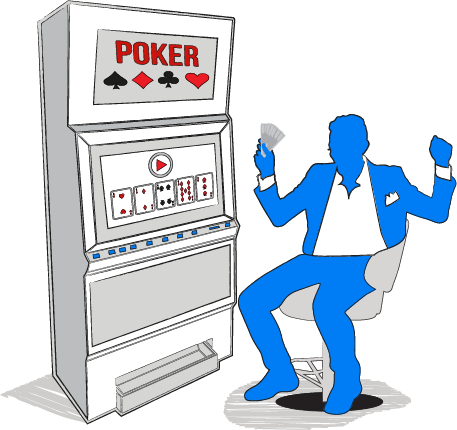
When you play a Live casino, the number of credits you play does not alter your percentage of return for your play. If you play standard American double zero roulette, you will lose 5.26 percent of every dollar you bet over the long run. If you bet 100 dollars, you will lose $5.26. If you bet 1,000 dollars you will lose $52.60. The amount you bet does not change your rate of return. It is always 94.74 percent of every dollar bet.
The same is true of many slot machines. Whenever the pays for playing more than one credit are nothing more than the number of credits times the pay for a one credit bet, it makes no difference how many credits you play. You will lose at the same rate per credit played regardless.
However, when a slot machine pays something extra for more credits played, whether it is a higher rate or additional winning hands, it generally makes sense to play the additional credits. For example, if you play the Megabucks slot machines, always play the maximum credits. Why should you do so? Simple - you have no shot at the jackpot unless you do. The Megabucks game has a terrible return, and the only reason you should play it is to have a shot at the jackpot, so play maximum credits on a Megabucks machine.
How about video poker games? As we have seen earlier in the guide, video poker games pay a bonus on the royal flush when the player bets maximum credits. Most of the time, the maximum number of credits is five – most of the time, but not always. Some casinos have video poker games that require 10 credits or more in order to qualify for the royal flush bonus. The higher maximum credit games are usually for the lower denominations with one credit being a quarter or less. Make sure you know what the maximum bet is before you start playing or you may be in for an unpleasant surprise. While you would have been playing $1.25 per hand on a quarter machine with a five credit maximum bet, you will be playing $2.50 per hand on a quarter machine requiring a 10 credit maximum bet. Your bankroll may not be able to tolerate the higher bet size.
BALANCE THE NUMBER OF CREDITS TO PLAY WITH DENOMINATION
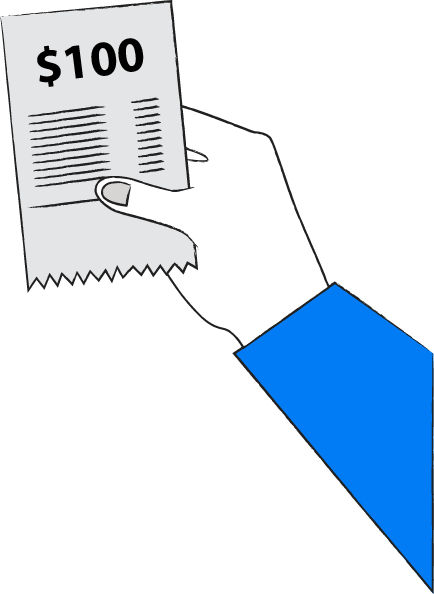
In order to gain the maximum advantage playing video poker, you also need to keep the level of play at a comfortable level. If you come to a casino with $100 and you are ready to play for an hour or more, you may think have a sucient bankroll to play a dollar game with a five credit maximum bet. Let’s look into this in a bit more detail. Five credits per hand on a dollar machine works out to five dollars a hand. At that rate, the one hundred dollars will only cover 20 hands if you have no winners in those hands. Trust me, 20 hands in a row without a win happens much more often than anyone would care to admit.
So one hundred dollars is not enough to play at a dollar video poker game. What about playing a 25 cent game?
It is certainly a better prospect. A 25 cent game with a five credit maximum bet requires $1.25 per hand. At that rate, the hundred dollar bill will cover the cost of 80 hands without a win over those hands. Depending on how fast you play, this could be as little as four minutes playing at a rate of 1,200 hands per hour. Even if you play at a more typical 600 hands per hour, the $100 bill will be gone after eight minutes of play if there are no wins in the 80 hands you play. Now chances are excellent that you will win some of the 80 hands and those wins will extend your time at the game. But will it be enough? I do not know the answer to that question. That is something only you can determine. The point I am trying to make is that even at a 25 cent game, one hundred dollars is not all that much money when playing the maximum bet.
BET WITHIN YOUR MEANS
Don’t get me wrong. If you have no diculty leaving the casino (or staying and not playing), the hundred dollars may be just fine. But if you would have diculty doing this, you have two choices;
- Play a lower denomination game
- Bring more money
If you are considering the first option, you should keep in mind that five cent games usually have a lower return and also tend to require 10 credits (or more) for a maximum bet so in most cases the maximum bet will be 50 cents. A bet of this size will roughly double your time at the game. In that longer timeframe time you will run the risk of losing more money because of the lower payback on the five cent games than if you played a 25 cent machine. Making the proper choice requires some analysis and thought to avoid any surprises.
If the second option is the one you prefer (bringing more money to the casino), just make sure you do not break the number one rule of sane gambling; do not bring more money than you can afford to lose.
Casinos are in business to make money. All their games are designed to ensure the casino takes your money. You must come with the expectation that you will lose everything you decide to bet. That may not happen all the time, but you must be ready for it and be able to accept that fact. Here are some guidelines.

For most people discipline is difficult. For many casino gamblers discipline can be nearly impossible. These five guidelines can help prop up flagging discipline and help make your casino gambling a pleasant and fun experience.
If neither of the above two options (playing a lower denomination game or bringing more money) is acceptable to you, the answer is simple. Do not go to the casinos until one of the options is acceptable.
KEY TAKEAWAYS







PAYBACK, RETURN AND HOUSE EDGE
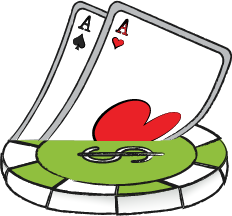
Whether or not you are aware of it, each and every game in a casino has a payback (which is also called a return) and a house edge. All three of these are inter-related. In this section we will look at exactly what each of these terms means and how each applies to casino table games, slot machines and video poker games.
Ready?
Alright, here we go.
PAYBACK IS WHAT THE GAME “PAYS YOU BACK”;
RETURN IS WHAT THE GAME RETURNS TO YOU.
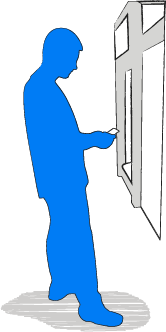
In the section we will look at each of these terms in some detail. Each of these terms is really self-defining. The term “payback” actually means what the game pays you back out of the money you feed into it. Return means what the game returns to you of the money you feed into it. As you can see, they mean the same thing. Because of this, the terms payback and return are used interchangeably.
I would guess that the vast majority of casino gamblers do not have a clue what the paybacks are for any of the common casino games. Yet each and every casino game has one. Of the common casino table games, blackjack is no doubt the most popular. Do you have any idea what the payback for blackjack is? What about another popular casino game – craps. Do you have any idea what the payback is for that game? How about roulette? Any idea what the return is for roulette?
If you have no idea, you are not alone. Most people go to a casino to enjoy themselves and hope to “get lucky” and make a big haul. They do not want to be bothered by boring details of the game they are about to play. Yet if you want to become a skilled player and extract all you can from the casino, knowing the payback or return and the house edge of the games you play is critical.
In order to get a feel for how good or bad the payback is for video poker, let’s look at some other casino games. Here are some of the paybacks for a few of the most popular casino table games.
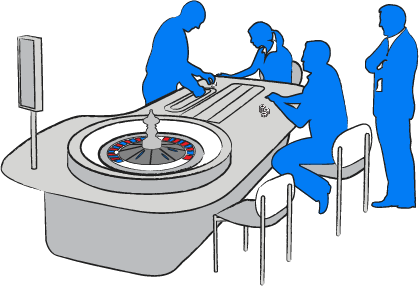
Roulette: 94.74 percent payback. This means for every 100 dollars you bet at the roulette wheel you will get paid back $94.74.
Blackjack: The payback for blackjack varies considerably based on the rules of the game. Consider a blackjack game that has six decks and good rules such as:
- blackjacks pay 3 to 2
- doubling allowed on any first two cards
- doubling after splitting a pair is allowed
- re-slitting pairs up to three times (making four hands) is allowed
- re-splitting aces is allowed
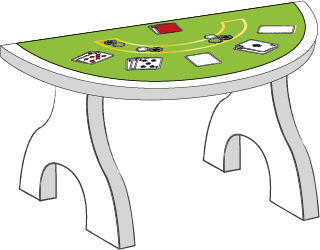
This blackjack game has excellent rules. You will probably not find many games with rules as good as these, but if you do, the payback is right around 99.65 percent. If you use the proper playing strategy, you will have $99.65 returned to you for every 100 dollars you bet.
As I stated before, most blackjack games do not have such favorable rules. The average payback for a blackjack game withdecent rules is about 99.5 percent. The payback can be reduced to about 98 percent with bad rules such as blackjacks paying 6 to 5 rather than 3 to 2.
PAYBACK (OR RETURN) CAN VARY WILDLY
The payback for craps is a bit more complicated. Why? There are so many different bets available in a craps game and almost every bet has a different payback. Here is a sample payback / return listing for craps bets.
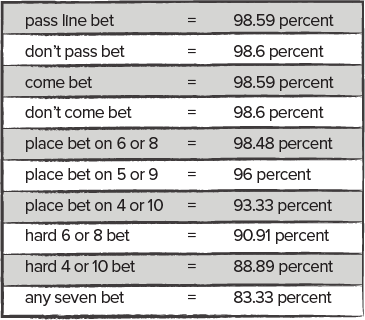

If you do not know what some of the bets in the list are, do not worry. It does not matter for this guide. This is only a sampling of the possible bets available while playing the game of craps. There are many more, some of which have paybacks as low as 75 percent. From this list you can see there is a wide range of paybacks for craps bets.
There is also a wide range of payback percentages in slots and video poker. A sharp player will know the return percentages for the table games he or she plays. These return percentages are widely available in books or by searching the internet. That same sharp player will also only play those games or place those bets that have the highest payback percentages.
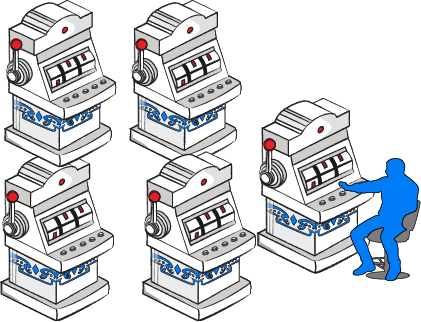
Slot machine payback percentages range from high of about 95 percent to a low of about 83 percent. You may be able to find a small group of slot machines in a few casinos that advertise a payback of “up to” 98 or even 99 percent, but these are extremely rare in today’s casino environment. Also keep in mind that in order for the statement “up to xx percent” to be accurate, only one machine of the group needs to have paid out that much in the past.
The problem with slot machines is the player has no real idea how high each machine’s payback actually is. Nothing on the machine gives the player enough information to be able to determine the payback.

Video poker games also have quite a large range of payback percentages. They go from a low of about 95 percent to a high of more than 100 percent in rare cases. The major difference is each video poker machine displays all of the information necessary to determine its payback percent.
The smart table games player will only play the games or make the bets that have the highest payback. Unlike playing slot machines, the smart video poker player can also choose the games that have the highest payback. In fact, the payback (or return) of a video poker game is most important criteria for picking a game to play.
HOUSE EDGE – HOW MUCH THE HOUSE KEEPS OF THE MONEY YOU PLAY
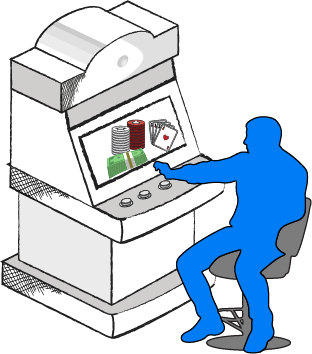
Payback or return is how much of the money you play is paid back or returned to you. Looking at it from the other side of the equation, the house edge is how much the house (casino) keeps of the money you play. If you know the payback or return of a game, you can easily calculate the house edge. You can also easily calculate the return or payback if you know the house edge. Since return is the money returned to you and house edge is the money that the house keeps; the sum of the return and house edge must equal 100 percent. Some video poker machines (though rare) have a return of more than 100 percent. The full pay Double Bonus Poker game mentioned in chapter one has a return of 100.17 percent. In order for the return plus the house edge to add up to 100 percent, the house edge for this game must be negative. It is, in actuality, a player edge. Examples of return/payback, house edge and total are shown in the list below.
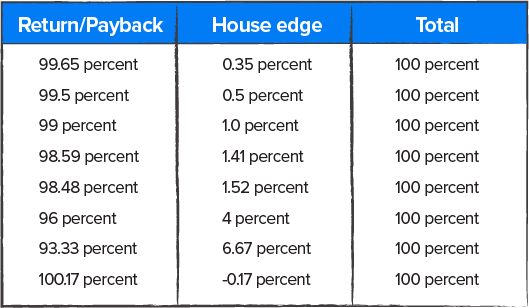
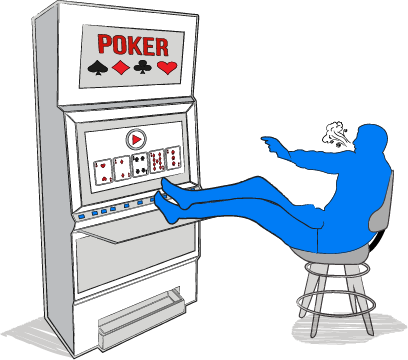
As detailed in this section, payback, return and house edge are all related. If you know one you know the others. The advantage of video poker is you can determine the return by the information displayed on the game. The returns and house edges of table games are also known by the public. This is not the case for any slot machines on the casino floor.
You may have noticed that some of the table games or that some bets on table games have very high returns and very low house edges. They are better, in fact, than a lot of video poker games. You may also ask, since return is the most critical factor in determining which video poker game to play, why not just play those table games and forget about video poker.
The answer?
A lot of people do play blackjack or craps. After a while, however, they get tired and want a more relaxed game where there are no hassles. Remember, you can play video poker at your own pace. You do not have to deal with other players that are at the same game, and you don’t have to worry about being ejected from the casino for playing video poker. That makes it a more relaxing game than table games, and it also has a very high return.
KEY TAKEAWAYS







VARIANCE / VOLITILITY
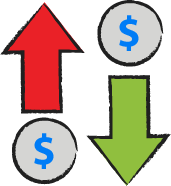
Two major factors determine the characteristics of a video poker game. They are the payback, which can also be stated as return or calculated from the house edge, and the variance or volatility. We examined how payback (or return) and house edge are inter-related in the last section. In this section we will look at the other half of what defines a video poker game – variance or volatility.
VOLATILITY – JUST HOW ROUGH A RIDE IS IT?

I am sure you have heard the term volatility used to describe things other than video poker. The term volatile is often used with terms such as gas prices or the stock market. When something is volatile, it is rough. It is bumpy. A volatile market has been called a roller coaster with high highs and low lows. First you shoot up very high and then you crash. Volatility is simply a generic term that indicates a rough ride much like a ship on rough seas.
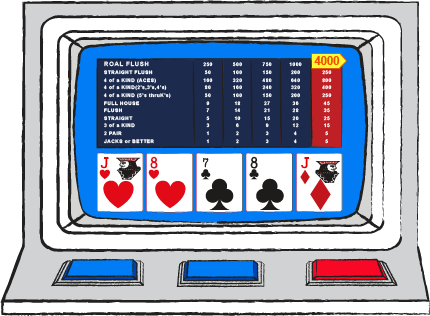
Volatility in video poker is very much the same thing. If you play a volatile video poker game you will experience the rough seas of bankroll swings. You will have high peaks in your bankroll thanks to multiple opportunities to win the several large jackpots oered in the game. You will sink to deep lows in your bankroll thanks to the fact the volatile video poker games must reduce the return of lesser paying, more frequent, hands in order to fund the additional high paying hands. Consider this example. If the casino offered a game where the dealer simply flipped a coin and you bet heads or tails and the casino would double your money every time you guessed right and take your bet every time you guessed wrong, your bankroll would fluctuate very little. After each flip you would either win one unit or lose one unit. Your bankroll would inch one way then the other, but you would seldom gain very much or lose very much. On the other hand, such a game would be very boring. There needs to be something more than just a one bet win or lose in order to garner the casino player’s interest. In video poker, even the most nonvolatile game has a jackpot associated with it. That jackpot is the royal flush. Chasing the royal flush is what puts excitement into the game of video poker. When there is only one jackpot and it appears very infrequently, the game has relatively low volatility. Taking the game of Jacks or Better as an example, the only real large win is the royal flush. Over the long run, a royal flush occurs about once in every 43,000 hands. The royal flush contributes about two percent to the overall return of the game. This means that for the 43,000 or so hands you play between royal flushes, you will lose at an additional rate (over the house edge of the game you are playing) of about two percent of the money you play through the game. There will be some minor ups and downs; ups as you hit a straight flush, four of a kind, or even a full house and a gradual down as you lose at about an additional two percent rate.
MORE LARGE PAYS – MORE VOLATILITY
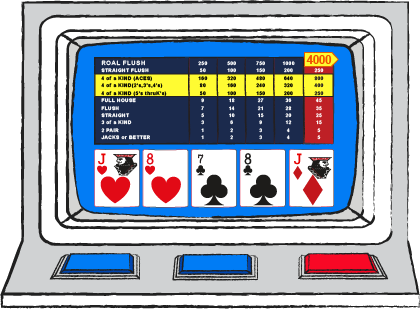
The game of Double Bonus Poker adds a large additional pay for a hand of four aces, bumping it to 160 for 1 from the 25 for 1 pay on the Jacks or Better Game. A hand of four 2’s, 3’s, or 4,s pays 80 for 1 rather than 25 for 1. Even four 5’s through kings pays 50 for 1 rather than the standard 25 for 1. All these additional higher paying hands increase the excitement of the game, but they also increase the volatility of the game. That is because in order to pay for the additional high paying hands, the pay for two pairs is reduced to 1 for 1 from 2 for 1. In Jacks or Better, the royal flush and straight flush winnings contribute about two and one half percent to the overall return. The winnings from hands containing two pairs contribute almost 26 percent. In Double Bonus Poker, the royal flush, straight flush and four of a kind hands contribute about 17.65 percent and the winnings for hands with two pairs contribute only about 12.5 percent. As you can see, there may be more high paying hands, but you also will lose much more quickly when you are not hitting the big hands. This happens thanks to the large reduction in the pay for two pairs. It contributes less than half of what it does in Jacks or Better. Consequently, the volatility of the Double Bonus game is significantly higher than it is for Jacks or Better.
VARIANCE – PUTTING A NUMBER ON VOLATILY
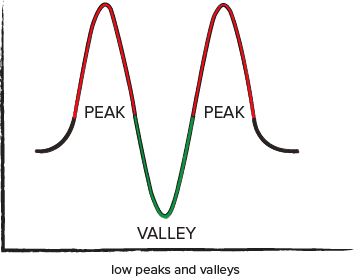
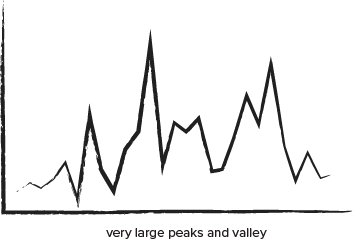
While many people use the terms volatility and variance interchangeably, the terms are different. Volatility describes the “bumpiness” caused to your bankroll by video poker (or any casino game for that matter). It is a generic term. Volatility has no magnitude of the bumpiness built into its definition. Variance on the other hand is a mathematical term that puts a number on the bumpiness. The variance of video poker games runs from a low of about 12 to 15 to a high that approaches 200. That is quite a range. Let’s look at some examples. Three of the more popular video poker games are Jacks or Better, Double Bonus Poker, and Double Double Bonus Poker. For the purposes of this section, we will look at the full pay games. The returns and (rounded) variance for each are:
Notice how the variance climbs as more of the game’s return is tied up in less frequent, higher paying hands. Looking at some specifics, assume you have a $300 bankroll and you plan to play a four hour session on a 25 cent game. For this example we assume you play 500 hands per hour. Therefore you will play 2,000 hands in your four hour session. If you are just looking to make the most (or lose the least) money, your game of choice would be Double Bonus Poker as it returns the most. But there is another consideration. The question you must ask yourself is: do you want to win or do you want to be able to have the best chance of playing the entire four hours. Variance makes a difference. The following table shows the average ending bankroll for the four hour session that began with a $300 bankroll. It also shows the “risk of ruin,” which is the percentage of times that you will lose all your money before the four hours are up.


As the table shows, you will end up with more money on average playing the full pay Double Bonus game. You are, however, also 10 times more likely to end up broke before completing four hours of play – about once every six sessions. On the other hand, while your ending bankroll will be $11 lower than is was at the beginning, you will go broke only once every 66 sessions playing Jacks or Better. If you can tolerate losing your entire stake every sixth session, the Double Bonus game may be for you. However, if you are really into the action, you are much better off playing the Jacks or Better game. Let’s look at it from another perspective. How large a bankroll is required while playing 10/7 Double Bonus poker to have the same 1.5 percent risk of ruin that we have with a $300 bankroll playing 9/6 Jacks or Better? Increasing the bankroll by $100 to $400 only lowers the risk of ruin to 4.4 percent. In order to have the same risk of ruin playing 10/7 Double Bonus Poker as a $300 bankroll playing 9/6 Jacks or Better requires a $460 bankroll. That is an increase of over 50 percent. As you can see, the variance of a game is an important factor, indeed a major factor, in determining the type of video poker game you choose to play. Do not forget to factor that into your criteria for choosing the video poker game you play.
KEY TAKEAWAYS



WHAT “RANDOM” MEANS FOR VIDEO POKER
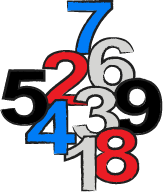
According to Wikipedia, “Random, or randomness, is the property of lacking any sensible predictability.”
In statistics, random means “of or characterizing a process of selection in which each item of a set has an equal probability of being chosen.”
We have all heard the term random and have an intuitive understanding of what the term actually means. In this section, you will explore in detail what, exactly, random means to the game of video poker.
RANDOMNESS AND ODDS
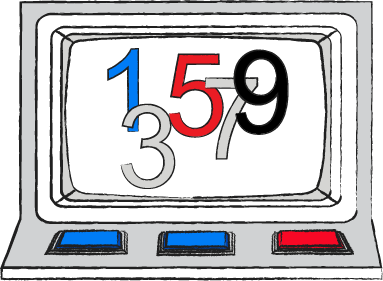
In video poker articles and books, you read about the odds of a particular hand being made. You read about the house edge of various games. Discussions of odds or house edge are always predicated on a random game. For example, in a random video poker game of full pay Jacks or Better, the odds of getting a four of a kind are about 1 in 423 hands.
Just what exactly does this mean?
Let me tell you what it does not mean. It does not mean that after you have played 422 hands without a four of a kind being produced that a four of a kind will appear as the next hand. It does not mean that after 800 hands a four of a kind will appear. It does not mean that after 1,200 hands or even 1,600 hands that a four of a kind will appear.
The whole concept of random is that the player cannot predict the outcome of the next hand. A particular hand is never due. If you deal from a complete deck and the deal is random, each hand that is completed has a one in 423 chance of being a four of a kind. It does not matter how many hands without a four of a kind have happened beforehand, the odds of producing a four of a kind are still one in 423 each and every hand. It is hard for the human mind to grasp that. It is hard for the human mind to come to terms with the concept of random.
IS THIS RANDOM OR ARE THERE PATTERNS?
The human mind hates random. Because of this, the mind tries to see patterns where, in fact, none exist.
Consider numbers presented below.
Notice how certain numbers are predominant at certain times and others are predominant at a different time. At one point in the series there are six 9’s in a row. Surely this is not random. Surely there are patterns to the numbers. There is a “flow” of numbers from high to low and back to high. Is that not true?

Actually, the number series above is 990 digits of the value of pi (Π) starting with the fourth digit after the decimal point. Pi is a mathematical constant whose value is the ratio of any circle’s circumference to its diameter. This is the same value as the ratio of a circle's area to the square of its radius. Pi is approximately equal to 3.14159. It is widely accepted that the digits representing the value of Pi are random.
As of August 5, 2010, the record for calculating the most digits of the value of pi was set at five trillion digits – five trillion digits without any series repeating. The value of pi can certainly be considered a random series of numbers.
I AM DUE FOR A FOUR OF A KIND, AM I NOT?
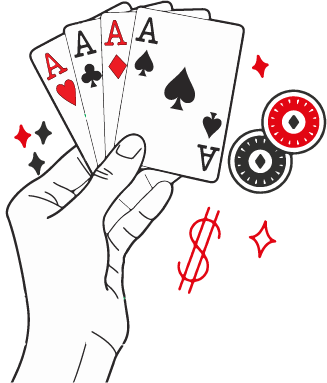
All the patterns that you may notice in the above series are random. No repeatable patterns exist. They cannot be predicted for the future. If you took the time to count all the occurrences of each digit in the five trillion digits of the value of pi, there would be approximately 500 billion of each digit zero through nine. The occurrences of each dfferent digit are randomly interspersed throughout the five trillion digits in no particular pattern. Similarly, even though randomness dictates that in the long run you will see a four of a kind once in every 423 hands played, the player has no idea how long it will be between the last four of a kind and the next. All that is certain is that the longer you play the more closely your results will come to the mathematical odds.
What is my point in presenting all the detail?
When playing video poker you may feel you are “due” at times. In fact, you are not “due.” You have exactly the same odds of getting a particular hand on the first hand played or the 50th hand played to the 500th hand played.
I know several players – skillful players – whom I trust are playing the correct video poker strategy. One of these players has played over 190,000 hands without getting a royal flush. If 190,000 were the long run, this player would have hit at least four royal flushes by now. And yet, there have been zero royal flushes for 190,000 hands. With each additional hand that is played there is a one in 43,000 chance of a hitting royal flush. Make no mistake, this player is not due. Maybe some of this long streak since this player’s last royal can be attributed to the fact that this player had three or four royal flushes in fairly short order prior to the current drought. Then again, maybe not. I do not know.
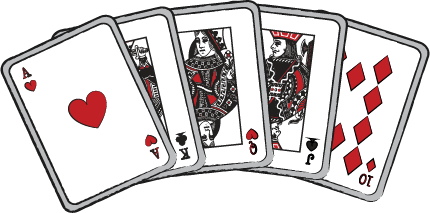
What I do know is that random is exactly that. It is random. You cannot predict what is coming next.
Randomness will affect all of your video poker play. There will be times you get lots of four of a kind hands. There will be other times there will be a dearth of them. This is all part of randomness manifesting itself in your video poker play. You cannot change it. All you can do is accept it and make sure you plan for it and have a large enough bankroll to handle the lean times.




HOW TO PLAY VIDEO POKER SUMMARY

In this chapter you learned the specifics of playing video poker. You also learned some of the details of the pay table and to make sure you check the entire pay table when determining how good or bad a game it describes. Unlike most slot machines and all casino table games, you must play the maximum credits in order to get the maximum benefit from your video poker play. You learned the importance of picking the proper denomination of video poker game to play. You now know the meaning of the terms payback, return, house edge, volatility and variance. Finally you learned that random means that you cannot predict what the future holds. You are never “due” for any particular hand.
In the next chapter you will learn several different categories of video poker games and some of the peculiarities of each category.
TEST YOURSELF
See if you can answer these questions based on the information presented in Chapter 2.










ANSWERS















